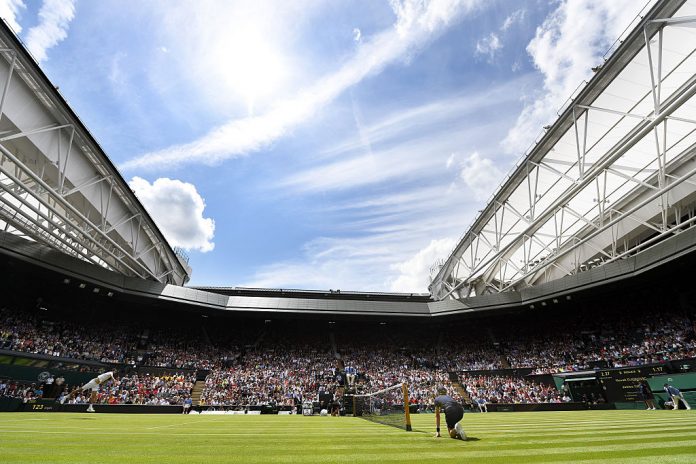Bill Simons
EN ROUTE TO LONDON—For over three decades each summer when I flew across the pond to old England to cover Wimbledon, it seemed like a comforting journey to a bygone domain of gentle swans and ancient traditions. After all, Britain with its tweeds, long established classes and “know your place” mores was the essence of old world stability: “Don’t rock the ship, lad. Stiff upper lip, old boy. Know your place, young whipper snapper.” Royals and realists reign here in this good and gray kingdom of profound poets and rowdy pubs.
But this is the year of Brexit. Now everything is different. The world had imploded. “If you read one thing, the world is going to come to an end,” one businessman told BBC. “And if you read another thing,” he continued, “the world is going to come to an end.”
So never mind that the raison d’etre of Winston Churchill – the foremost political figure in modern British history – was to prevent any of his land’s colonies from exiting the Empire that he was certain was the prime agency for bringing civilization to a world of heathens. And also never mind Beatle John Lennon. The UK’s greatest post-World War II entertainer was a visionary who, in his utopian anthem “Imagine,” envisions a world without war, borders and, get this, even nations.
But that was aspirational ’60s idealism – peace out. The British Invasion from back then is now but a memory. Today 21st century realism prevails. Brexit – which was fueled by fear and anger – is very much in place.
The British papers shout out an array of takes on Brexit. Some headlines were worrisome: “A Nation Split in Two,” “We Are United in Total Disbelief,” “Blow to Industry” and “Will the EU Crumble?”
Others are wildly celebratory. “Take a Bow Britain – It was the day the quiet people of Britain rose up against an arrogant, out-of-touch political class and a contemptuous Brussels elite.”
The Daily Telegraph said Brexit “was a more impressive achievement than the French Revolution.” Writer Andrew Roberts contended, “Today’s insurgent leaders were a ragtag bunch: a half-albino classicist whose friends call him ‘the truffle pig’; a German-born Labor MP; a beer-drinking, cigarette-smoking man of the people; an infinitely courteous intellectual with a razor-sharp brain, who nevertheless had been sacked as Education Minister a few years ago.”
But hold on, don’t we Americans know a thing or two about ragtag insurgent leaders? Our 1776 rebels dumped tea into the bay and our feisty farmers picked off Redcoats from behind boulders. America’s long-ignored colonists had had it with a distant, arrogant bureaucracy that didn’t get it. Taxation without representation doesn’t cut it.
Let’s face it, America was all about Brexit before Brexit was cool. And revolutionaries like Paul Revere, John Hancock and George Washington (who against all odds successfully led an exit campaign from the British Empire) were precursors to an array of fellows like Gandhi in India or Nasser in Egypt who rose up to demand that Mother England exit their lands.
Still, as the pundits wondered whether the EU would disintegrate or the world economy would waver, tennis observers knew one thing: within our little game, Wimbledon is the keeper of the faith. It’s the mother church of tradition, the confident unblinking guardian of sporting civility. Pomp and propriety ooze from every well-scrubbed corner of the All England Lawn Tennis Club, whether it be the grand St. Mary’s walk, the fabled Competitors Locker Rooms, the Tea Room or the Members Enclosure.
It’s not that Wimbledon hasn’t faced it’s own Wexit (i.e. Wimbledon exit) insurgencies. In 1973 ATP pros were incensed by the heavy-handed moves of Yugoslavia’s tennis federation and successfully joined together and initiated a one-year boycott that empowered the players. The tennis landscape was never the same.
The up-against-the-wall rage ‘n rants of raw rebels McEnroe and Connors were nothing if not a cultural counter point to the sedate ethos of sleepy Wimbledon. “You cannot be serious!” yelled the young Yankee.
But Wimbledon is serious, seriously complex.
Truth be told, no other sports organization so adeptly brands quaint traditions while quietly, but incessantly, initiating cutting-edge changes. Yes, we know, white gear, grass courts, the oh-so-proper Royal Box, clipped language spoken in hush tones, retro unies worn by umps and ivy walls that exude tradition all give Wimbledon its unique allure. Pimm’s, purple petunias and strawberries and cream prevail.
Yet, you can’t miss the place’s dazzling space-age roof, its impressive new stadiums and a high-tech culture. Change at other Slams is a crapshoot. Sometimes you see it, other times the tournaments are stuck in the mud. Not Wimbledon. Here change is an art form – quiet, constant and, most important, seamless.
Yes, Royals still hand out elegant trophies and Centre Court seems like a subdued cathedral worthy of well-heeled reverence. Fans can get loud, but are never rowdy. Old-school sensibilities still prevail. Colored bra straps are strictly forbidden. Shame on you Nike, your skirts were too short. And how could you so violate our rules Mr. Federer, the soles of your shoes had some color.
Still, many a previous tradition has been “Brexited.” No longer are female chair umps and ball persons banned from Centre Court. Players no longer play with white balls and they don’t have to bow or curtsey to Royals. Wimbledon has shown a little flexibility in previously rigid start times and authorities even opened up Centre Court a couple of times to the masses.
As for exits, the place mints ’em like Sharapova makes her Sugarpova. America’s fiery Jeff Tarango was tossed out of his 1995 match against Alexander Mronz. Soon his wife at the time twice slapped ump Bruno Rebeuh, who Tarango called “one of the most corrupt officials in the game.” He was banned from Wimbledon the next year.
Then again, even England’s well-bred hero, Oxfordian Tim Henman, was tossed from a doubles match after he accidentally bashed a ball girl with a ball. American Murphy Jensen “Brexited” Wimbledon in 1995 when he skipped out of a mixed doubles match to go fishing. When 1999 French Open finalist Martina Hingis, the No. 1 player in the world, was bumped out of Wimbledon by No. 129 Jelena Dokic, Ian Woolridge claimed, “The sheer enormity, the staggering implausibility…of this hard to ignore defeat heaps humiliation on the shame she already felt [for melting down during her loss at the French Open final].”
For years Spanish players who prevailed on the continent’s clay courts couldn’t be bothered with the challenge of Wimbledon’s slick grass courts and just skipped out.
To his great credit, Rafa Nadal changed all that by embracing grass court play. Ironically, the Spaniard, with his losses to the likes of Lukas Rosol, Dustin Brown and Nick Kyrgios, has suffered more shock Wimbledon exits than any other player. Then again, shock exits are the by-products of both the English electorate and Wimbledon’s grass courts. Goodness, old Court Two was long been called the upset court. In the fourth round in 2001, teen Roger Federer ended Pete Sampras’ effort to win a record fifth straight Wimbledon. It was an upset that announced the changing of the guard. A year later, the little-known Swiss player George Bastl upset Sampras. They may not have had the historical significance of Brexit – still tennis observers see them as benchmarks, just as historians will long see Brexit as a shock moment for Britain, Europe and the world.



















